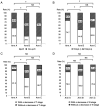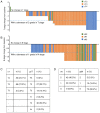Pretreatment high cholesterol and low neutrophils predict complete pathological response after neoadjuvant short‑course radiotherapy followed by chemotherapy and immunotherapy in locally advanced rectal cancer
- PMID: 37332340
- PMCID: PMC10272967
- DOI: 10.3892/ol.2023.13905
Pretreatment high cholesterol and low neutrophils predict complete pathological response after neoadjuvant short‑course radiotherapy followed by chemotherapy and immunotherapy in locally advanced rectal cancer
Abstract
The present study was aimed at looking for hematological indicators that could predict pathological complete response (pCR) in patients with locally advanced rectal cancer (LARC) treated with short-course radiotherapy (SCRT) followed by chemotherapy and immunotherapy. A total of 171 patients were enrolled in this observational retrospective study. Pretreatment values of albumin, total cholesterol, lactate dehydrogenase, neutrophil, platelet and lymphocytes were available. Univariate and multivariate logistics analyses were used to determine the prognostic factor for pCR. SCRT followed by chemotherapy and immunotherapy was demonstrated to double the pCR rate (50.5%) compared with long-course chemoradiotherapy. For the former group, baseline high platelet to lymphocyte ratio (P=0.047), high cholesterol (P=0.026) and low neutrophils (P=0.012) level were associated with high pCR rate and baseline high cholesterol (P=0.016) and low neutrophils (P=0.020) level were the independent prognostic factors for pCR. In conclusion, pretreatment high cholesterol and low neutrophils were the independent prognostic predictors of pCR in patients with LARC treated with SCRT followed by chemotherapy and immunotherapy. Clinical trial no. NCT04928807, June 16, 2021.
Keywords: immunotherapy; locally advanced rectal cancer; pathological complete response; short-course radiotherapy.
Copyright © 2023, Spandidos Publications.
Conflict of interest statement
The authors declare that they have no competing interests.
Figures



Similar articles
-
Current status of neoadjuvant therapy for locally advanced rectal cancer in Wuhan Union Hospital Cancer Center.Radiat Oncol. 2022 Jun 20;17(1):109. doi: 10.1186/s13014-022-02081-8. Radiat Oncol. 2022. PMID: 35718789 Free PMC article.
-
Comparison of pathological complete response rates after neoadjuvant short-course radiotherapy or chemoradiation followed by delayed surgery in locally advanced rectal cancer.Eur J Surg Oncol. 2018 Jul;44(7):1013-1017. doi: 10.1016/j.ejso.2018.03.014. Epub 2018 Mar 23. Eur J Surg Oncol. 2018. PMID: 29650419
-
Dose escalation of preoperative short-course radiotherapy followed by neoadjuvant chemotherapy in locally advanced rectal cancer: protocol for an open-label, single-centre, phase I clinical trial.BMJ Open. 2019 Mar 23;9(3):e025944. doi: 10.1136/bmjopen-2018-025944. BMJ Open. 2019. PMID: 30904869 Free PMC article.
-
Strategies to Optimize Treatment for Locally Advanced Rectal Cancer.Cancers (Basel). 2022 Dec 29;15(1):219. doi: 10.3390/cancers15010219. Cancers (Basel). 2022. PMID: 36612213 Free PMC article. Review.
-
Is adjuvant chemotherapy necessary for locally advanced rectal cancer patients with pathological complete response after neoadjuvant chemoradiotherapy and radical surgery? A systematic review and meta-analysis.Int J Colorectal Dis. 2019 Jan;34(1):113-121. doi: 10.1007/s00384-018-3181-9. Epub 2018 Oct 27. Int J Colorectal Dis. 2019. PMID: 30368569
Cited by
-
Neoadjuvant chemoradiotherapy with or without preoperative immunotherapy for locally advanced rectal cancer: a system review and meta-analysis.Updates Surg. 2025 Jul 5. doi: 10.1007/s13304-025-02309-8. Online ahead of print. Updates Surg. 2025. PMID: 40616745 Review.
-
Prophylactic antibiotic use is associated with better clinical outcomes in gastric cancer patients receiving immunotherapy.Oncologist. 2025 Feb 6;30(2):oyae362. doi: 10.1093/oncolo/oyae362. Oncologist. 2025. PMID: 40036772 Free PMC article.
References
-
- Bahadoer RR, Dijkstra EA, van Etten B, Marijnen CAM, Putter H, Kranenbarg EM, Roodvoets AGH, Nagtegaal ID, Beets-Tan RGH, Blomqvist LK, et al. Short-course radiotherapy followed by chemotherapy before total mesorectal excision (TME) versus preoperative chemoradiotherapy, TME, and optional adjuvant chemotherapy in locally advanced rectal cancer (RAPIDO): A randomised, open-label, phase 3 trial. Lancet Oncol. 2021;22:29–42. doi: 10.1016/S1470-2045(20)30555-6. - DOI - PubMed
-
- Bujko K, Nowacki MP, Nasierowska-Guttmejer A, Michalski W, Bebenek M, Kryj M. Long-term results of a randomized trial comparing preoperative short-course radiotherapy with preoperative conventionally fractionated chemoradiation for rectal cancer. Br J Surg. 2006;93:1215–1223. doi: 10.1002/bjs.5506. - DOI - PubMed
Associated data
LinkOut - more resources
Full Text Sources
Medical
